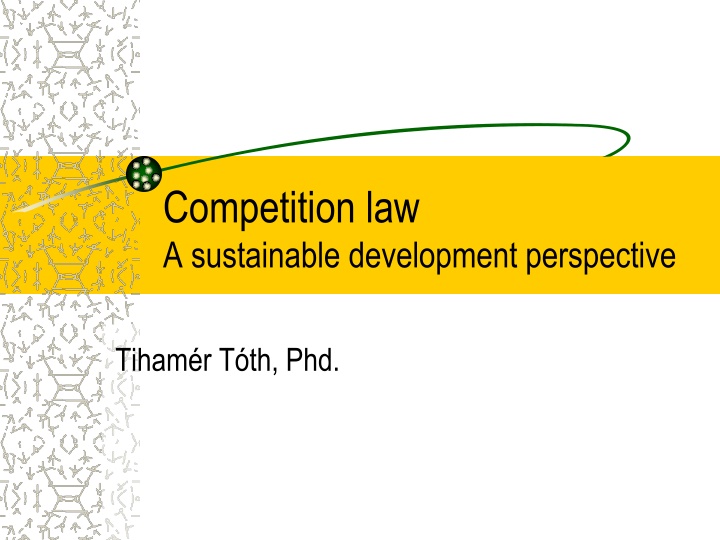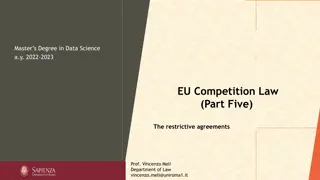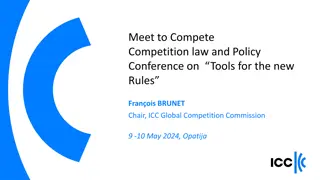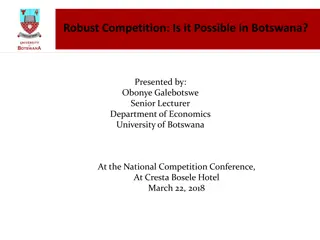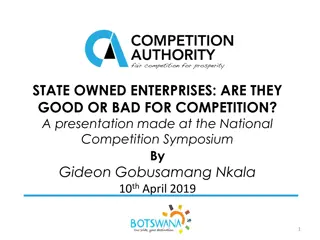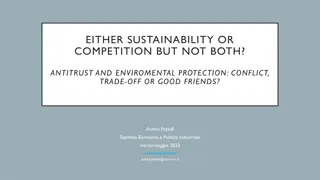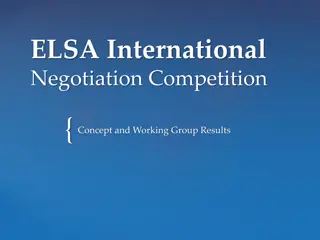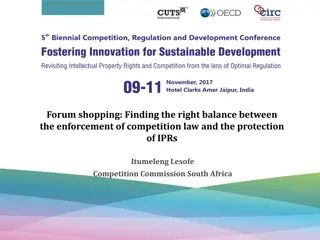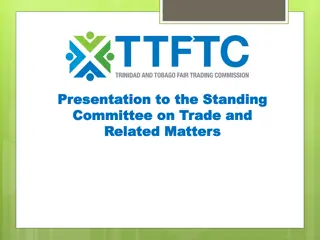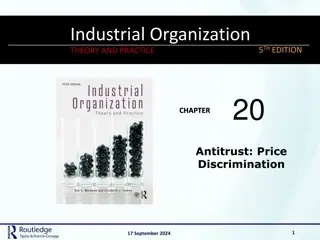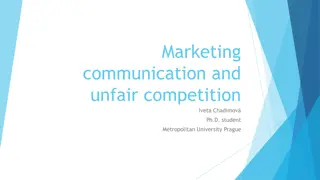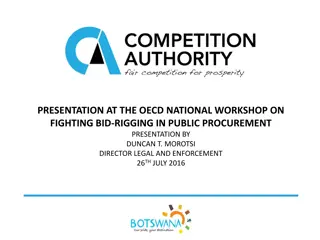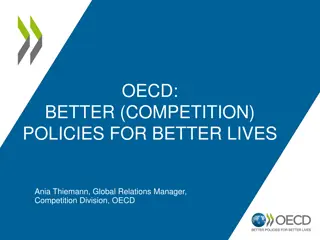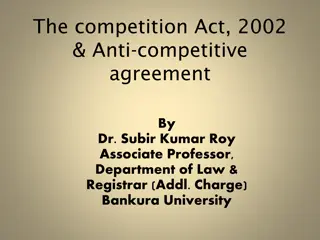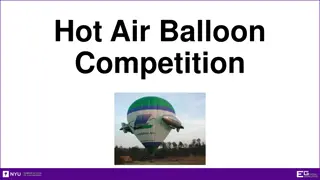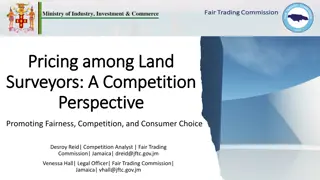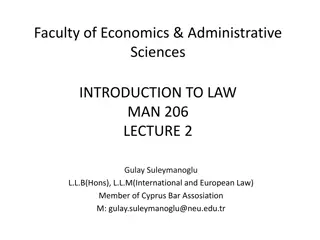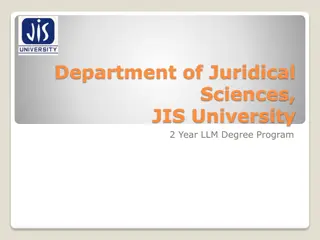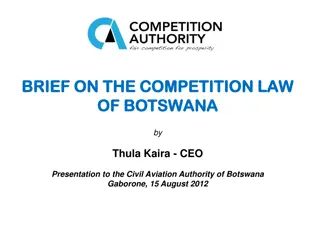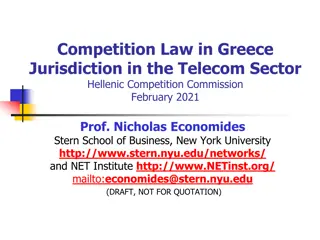Competition law
Perspective on how competition law can promote sustainable development, explored in the Tihamr Tth, PhD thesis. The implications and applications of competition law in the context of sustainable development are discussed.
Download Presentation

Please find below an Image/Link to download the presentation.
The content on the website is provided AS IS for your information and personal use only. It may not be sold, licensed, or shared on other websites without obtaining consent from the author.If you encounter any issues during the download, it is possible that the publisher has removed the file from their server.
You are allowed to download the files provided on this website for personal or commercial use, subject to the condition that they are used lawfully. All files are the property of their respective owners.
The content on the website is provided AS IS for your information and personal use only. It may not be sold, licensed, or shared on other websites without obtaining consent from the author.
E N D
Presentation Transcript
Competition law A sustainable development perspective Tiham r T th, Phd.
The menue: coverage of EU competition law Rules applicable to MSs Antitrust State aid Anti-competitive agreements State monopolies, exclusive rights Abuse of dominance Anti-competitive state measures M & A
Discussion What is competition? Is competition good or bad? Example: strong/fierce competition? Example: week competition?
What is competition? A situation in which firms independently strive for buyers patronage in order to achieve a particular business objective (profits, sales, market share) - rivalry. A process whereby market actors participate in the economy without overwhelming contraints from private or public power. Is competition (economic freedom) a value in itself, or just an instrument to maximize welfare?
Competition why? The best mechanism for ensuring effective allocation of resources Pressure towards lower prices and more innovation and choice Provides the widest possible freedom of action to all Can the state not perform all these tasks?
Is competition good or bad? Just as the unity of human society cannot be founded on an opposition of classes, so also the right ordering of economic life cannot be left to a free competition of forces. ( ) But free competition, while justified and certainly useful provided it is kept within certain limits, clearly cannot direct economic life. ( ) competition can still less perform, since it is a headstrong power and a violent energy that, to benefit people, needs to be strongly curbed and wisely ruled. But it cannot curb and rule itself. Pope Pius XI, Quadragesimo anno, 88.
Competition: good or bad? [T]oday everything comes under the laws of competition and the survival of the fittest, where the powerful feed upon the powerless. As a consequence, masses of people find themselves excluded and marginalized: without work, without possibilities, without any means of escape. Pope Francis
Competition: good or bad? Economy and finance, as instruments, can be used badly when those at the helm are motivated by purely selfish ends. Instruments that are good in themselves can thereby be transformed into harmful ones. But it is man's darkened reason that produces these consequences, not the instrument per se. Therefore it is not the instrument that must be called to account, but individuals, their moral conscience and their personal and social responsibility Pope Benedict, Caritas in Veritate
Competition and sustainability Competition law paradigm of individual agents, seeking self-interested profit-maximization, short/medium term consideration of mainly price effects Race to the bottom, firms imposing a negative externality to maximize profits Energy pollution to cut costs Should competition policy promote well- being/happiness? Material + quality of life, including environmental considerations
Competition and sustainability - EU The Union shall establish an internal market. It shall work for the sustainable development of Europe based on balanced economic growth and price stability, a highly competitive social market economy, aiming at full employment and social progress, and a high level of protection and improvement of the quality of the environment. Article 3(3) TFEU
Environment in the TFEU Shared competence (vs. EU competition policy) Article 11: Environmental protection requirements must be integrated into the definition and implementation of the Union's policies and activities, in particular with a view to promoting sustainable development. Art. 191. Principles of EU environmental policy: precautionary principle, preventive action should be taken, and that the polluter should pay.
Anti-competitive agreements Article 101 TFEU
What is missing? The incompatible with the internal market: all agreements between undertakings, . by associations of and . which may affect trade between Member States and which have as their object . effect the prevention, restriction or distortion of competition within the internal market following shall be prohibited as
Who is an undertaking? The notion of economic activity Diego Cali (Port of Genova) case Anti-pollution surveillance services Performed by a company entrusted with this right by the State Users paying a fee for the service Protection of the environment is part of the powers of the public authority, lacking an economic nature
Types of business conduct covered under Article 101 Cartels JV, COOPERATION
Competition restrictions By object Price cartels Quota cartels Status quo cartels Information exchange on future prices Fixing retail prices for distributors Total prohibition of parallel trade for distributors (absolute territorial protection) By effect Most information exchanges Joint production Joint procurement/selling Standardisation Non-compete in distribution Exclusive distribution Selective distribution
Lawful competition restrictions De minimis (minor) restrictions of competition Article 101 (3) TFEU: exception with 4 criteria: Economic development (efficiencies) Fair share to consumers No unnecessary restrictions No elimination of competition VW/Ford JV case
EC block exemption regulations Vertical [2790/99 Commission Regulation] Motor vehicle distribution and servicing Technology transfer R&D Specialisation Insurance Vertical and Horizontal Commission Guidelines!
JV agreements v. cartels Competitors Cartels: by aim infringement (naked restrictions), no efficiency justification, often secret Crime in many countries JV: effects based approach BER, individual exception and de minimis available
Is this a cartel? Overproduction of beef in Ireland; Government urged companies to solve the problem Aim: reduce the total capacity of the processing industry by 25% within one year The Beef Industry Developments Society decided to set up a fund financed by market share related contributions to provide compensation to slaughter houses cutting back their capacities; they had to agree not to re- enter the market for 2 years
Discussion Two engineering companies that produce vehicle components agree to set up a JV to combine their R&D efforts to improve the production and performance of an existing component. The production of that component would also have a positive effect on the environment: vehicles would consume less fuel and therefore emit less CO2 . The companies will continue to manufacture and sell the components separately. The two companies have market shares in the Union of 15 % and 20 % on the Original Equipment Manufacturer ( OEM ) product market. The product life cycle for the component is typically two to three years.
Horizontal guidelines Auto R&D JV, maintain own production Consume less fuel and therefore emit less CO2 Does market structure matter? Can environmental factors be considered under Article 101 (3)?
Discussion The European Association of Washing Machines discussed the state of play of manufacturing machines consuming less water and electricity. A decision was adopted obliging its members to gradually phasing out the production of machines not meeting the agreed water and energy consumption levels. Discuss: (1) can this be regarded as an anti-competitive agreement (2) can it be justified under Article 101 (3) TFEU?
Abuse of dominance Article 102 TFEU
What is missing? Any by one or more undertakings of a . .position within the internal market or in a substantial part of it shall be prohibited as incompatible with the internal market in so far as it .trade between Member States.
Abuse of a dominant position Existence of a dominant position Definition of the relevant market Single or collective dominance Abuse by one or more undertakings Exploitative: consumers hurt (i.e. unfairly high prices) Exclusionary: competitors suffer (market foreclosure) May affect interstate trade Note: no exception/exemption system But: Art. 106 (2) Justifications
Abuse Charging unreasonably high prices Charging different prices based upon the nationality of the buyer Selling at artificially low prices efficient competitors can't compete with Refusing to deal with certain customers or offering special discounts to customers who buy all or most of their supplies from the domco Making the sale of one product conditional on the sale of another product
ARA decision Commission fined Altstoff Recycling Austria (ARA) EUR 6 million for blocking competitors from entering the Austrian market for management of household packaging waste from 2008 to 2012 Essential facility: ARA s nationwide collection infrastructure Press release: greater recycling and re-use brings benefits for both the environment and the economy
The control of M&As Maintainig competitive market structures
M&A rules in a nutshell Council Regulation 139/2004 EC (4064/89 EC) Commission implementing regulation Guidelines, notices SIEC (dominance) test, forward-looking Ex ante control: notification and suspension Community dimension - One stop shop for concentrations above the thresholds
M&A The SIEC test 4064/89: a dominant position will be created or strengthened as a result of which effective competition would be impeded in the common market or in a substantial part of it 139/2004: which would significantly impede effective competition in the common market or in a substantial part of it, in particular as a result of the creation or strengthening of a dominant position
M&A The SIEC test II. The structure of competitive assessments: Defining the relevant market(s) Analysing the state and future of competition (horizontal, vertical, portfolio and conglomerate effects) Covers both single firm and collective dominance Is sustainable development ever an issue?
Consequences of M&As Balancing Benefits of concentrations Increased market power The ability of one or more firms to profitably raise prices, reduce output, choice or quality, diminish innovation Economies of scale and scope (efficiencies)
An M&A case U.S. EnergySolutions waste disposal: court blocked merger of Waste Control Specialists and its biggest rival, Energy Solutions Would have combine the only two commercial low-level radioactive waste disposal facilities for 36 states radioactive byproducts of nuclear power generation, scientific research and certain medical treatments Competition can lead to better disposal services at lower prices Environmentalists: less sites: more movement of waste
Anti-competitive State actions State aid
The prohibition of state aid Article 107(1) of the TFEU covers any form of state aid which meets the following criteria cumulatively: involves an economic advantage to undertakings; that advantage is selective (individual/sectoral/regional, as opposed to general policy instruments governing economic policy); it is financed directly or indirectly through State resources and is attributed to the State; it distorts competition; and it affects trade between Member States.
The rules of the state aid game The European Commission has exclusive competence to approve aid State aid has to be notified before granting (the standstill obligation of Article 108 (3) TFEU) Exceptions to the notification obligation: de minimis aid, aid that falls within a block exemption, and compensation for public services.
Green aid Protecting the environment can be a European common objective justifying state aid Block exemption regulation no need to notify Investment aid Going beyond Community standards + max 35% aid intensity, excluding waste management Early adaptation to future Community standards for SMEs: 15% Enabling to achieve energy savings: 60% High-efficiency co-generation: 45% Promotion of energy from renewable energy sources: 45%
Internal market law Freedoms (free movement of goods, .) Restriction can be justified if necessary and proportionate Protection of environment can be a justification Contrasting private and public restrictions of competition/trade: why is there no green exemption in antitrust?
